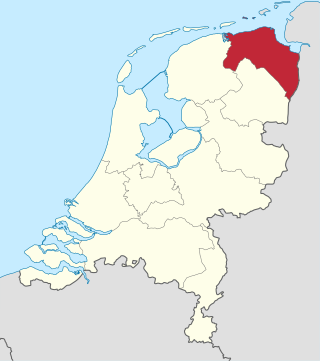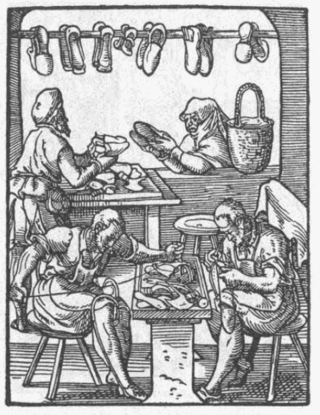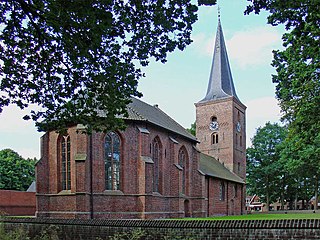
Groningen is the northeasternmost province of the Netherlands. It borders on Friesland to the west, Drenthe to the south, the German state of Lower Saxony to the east, and the Wadden Sea to the north. As of February 2020, Groningen had a population of 586,309 and a total area of 2,960 km2 (1,140 sq mi).

Groningen is the capital city and main municipality of Groningen province in the Netherlands. The capital of the north, Groningen is the largest place as well as the economic and cultural centre of the northern part of the country; as of December 2021, it had 235,287 inhabitants, making it the sixth largest city/municipality in the Netherlands and the second largest outside the Randstad.

Drenthe is a province of the Netherlands located in the northeastern part of the country. It is bordered by Overijssel to the south, Friesland to the west, Groningen to the north, and the German state of Lower Saxony to the east. As of November 2019, Drenthe had a population of 493,449 and a total area of 2,680 km2 (1,030 sq mi).

Eelde is a town in the Dutch province of Drenthe. It is a part of the municipality of Tynaarlo, and lies about 9 km south of Groningen. Groningen Airport Eelde is located near the village.

Clogs are a type of footwear made in part or completely from wood. Used in many parts of the world, their forms can vary by culture, but often remained unchanged for centuries within a culture.

Geta (下駄) are traditional Japanese footwear resembling flip-flops. A kind of sandal, geta have a flat wooden base elevated with up to three "teeth", held on the foot with a fabric thong, which keeps the foot raised above the ground.

Shoemaking is the process of making footwear.

Barger-Compascuum is a village in the Dutch municipality of Emmen. It is in a peat-producing region of Drenthe. Veenpark, an open-air museum, is dedicated to the peat history of the region.

Groningen Airport Eelde is a minor international airport in the northeastern Netherlands. It is located near Eelde in the Province of Drenthe, 4.8 nautical miles south of the city of Groningen in the province of Groningen. In 2015, the airport handled 220,710 passengers. The airport is also the home base of the KLM Flight Academy, Noord Nederlandse Aero Club (NNAC) and General Enterprises.

Zuidlaren is a village in the province of Drenthe in the Northern Netherlands. Zuidlaren has just over 10,000 inhabitants and is situated on natural heightened land which is called the Hondsrug.
Crocs, Inc. is an American footwear company based in Broomfield, Colorado, that manufactures and markets the Crocs brand of foam clogs.

Pattens, also known by other names, are protective overshoes that were worn in Europe from the Middle Ages until the early 20th century. In appearance, they sometimes resembled contemporary clogs or sandals. Pattens were worn outdoors over a normal shoe, had a wooden or later wood and metal sole, and were held in place by leather or cloth bands. Pattens functioned to elevate the foot above the mud and dirt of the street, in a period when road and urban paving was minimal. Women continued to wear pattens in muddy conditions until the 19th or even early 20th century.

A getabako (下駄箱) is a shoe cupboard in Japan, usually situated in the genkan, an entryway or porch of the house. This is often called a cubby in the United States. In Japan, it is considered uncouth to not remove one's shoes before entering the house. Near the getabako is a slipper rack, and most people in Japan wear slippers around the house, except for rooms which have tatami flooring, as they are bad for the floor. The getabako is usually made of wood and bamboo, and there are many sold all over the world.
MacGregor Golf is a sports equipment manufacturing company based in Albany, Georgia, which specializes in golf. MacGregor currently produces a wide range of golf clubs, bags, and accessories.

The Drents Museum is an art and history museum in Assen, Drenthe, in the Netherlands. The museum was opened in 1854. It has a collection of prehistorical artifacts, applied art, and visual art. The museum also has temporary exhibitions. In 2013, it had 227,000 visitors.

Namaksin is a kind of traditional Korean clog made of wood for protection against mud and rain. Namaksin are known as close-toed shoes made of one piece of wood. There was a misconception that these traditional clogs came not from Asia but from the Netherlands in the past, but in reality, there had been clogs at least from Three Kingdoms period of Korea, which were similar to geta, Japanese clogs. Those old namaksin were called "pyeonggeuk (平屐)". It is presumed that clogs of Baekje went to Japan, and it became the origin of geta. Clogs in Baekje had three holes like geta, but clogs in Silla had five holes. How people tied its strings in that era is unclear. In the Three Kingdoms period, there were two types of clogs: open-toes shoes, and close-toes shoes. As time went by, the latter became primary as namaksin. These shoes were worn by Koreans of all ages and social positions, usually in the rainy seasons.

SONS Museum (Shoes or No Shoes) is a Belgian museum dedicated to contemporary art connected to shoes as the subject. The museum is located at Kruishoutem, Belgium.

A klomp is a whole-foot clog from the Netherlands. Along with tulips and windmills, they are strongly associated with the country and are considered to be a national symbol of the Netherlands.

A sabot is a clog from France or surrounding countries such as The Netherlands, Belgium or Italy. Sabots are either whole-foot clogs or a heavy leather shoe with a wooden sole.

A British clog is a wooden-soled clog from Great Britain. The uppers are typically leather, and many variations exist in style and fastening.

















